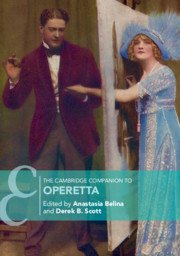Book contents
- The Cambridge Companion to Operetta
- Cambridge Companions to Music
- The Cambridge Companion to Operetta
- Copyright page
- Contents
- Illustrations
- Tables
- Music Examples
- Notes on Contributors
- Chronology, 1855–1950
- Introduction
- Part I Early Centres of Operetta
- 1 French Operetta: Offenbach and Company
- 2 Viennese Golden-Age Operetta: Drinking, Dancing and Social Criticism in a Multi-Ethnic Empire
- 3 London and Gilbert and Sullivan
- 4 Hungarians and Hungarianisms in Operetta and Folk Plays in the Late-Habsburg and Post-Habsburg Era
- 5 Operetta in the Czech National Revival: The Provisional Theatre Years
- Part II The Global Expansion of Operetta
- Part III Operetta since 1900
- Select Bibliography
- Index
- References
2 - Viennese Golden-Age Operetta: Drinking, Dancing and Social Criticism in a Multi-Ethnic Empire
from Part I - Early Centres of Operetta
Published online by Cambridge University Press: 14 November 2019
- The Cambridge Companion to Operetta
- Cambridge Companions to Music
- The Cambridge Companion to Operetta
- Copyright page
- Contents
- Illustrations
- Tables
- Music Examples
- Notes on Contributors
- Chronology, 1855–1950
- Introduction
- Part I Early Centres of Operetta
- 1 French Operetta: Offenbach and Company
- 2 Viennese Golden-Age Operetta: Drinking, Dancing and Social Criticism in a Multi-Ethnic Empire
- 3 London and Gilbert and Sullivan
- 4 Hungarians and Hungarianisms in Operetta and Folk Plays in the Late-Habsburg and Post-Habsburg Era
- 5 Operetta in the Czech National Revival: The Provisional Theatre Years
- Part II The Global Expansion of Operetta
- Part III Operetta since 1900
- Select Bibliography
- Index
- References
Summary
Viennese operetta, while partly modelled on Offenbach, was also shaped by the city’s role as the centre of a multicultural empire and by its vibrant earlier tradition of popular musical theatre. The Volkstheater heritage included an emphasis on Viennese identity and character types, the depiction of ethnic and class differences and ironic sociopolitical critiques. These blended easily with the French operetta tradition. Plots of Viennese operettas often emphasized the mixture of many types of people: rich and poor, masters and servants, country and city folk and, of course, the various ethnicities of Austria-Hungary, such as Czechs, Hungarians, Gipsies and Jews. Social dances were featured in both plot and music, with the typical Viennese waltz playing the key role of showing that no matter what foreign exotic characters crossed the stage, Austrian identity was the true centre of the universe and romantic love. Dramatic finales and simple couplets with improvised stanzas were additional musical staples. Sentimentality was central to Viennese operetta, but a good dose of realism lay behind it. Even though various peoples were represented as stereotypes, operetta brought out the empire’s diversity and presented the idealistic possibility that mutual understanding could help it endure.
- Type
- Chapter
- Information
- The Cambridge Companion to Operetta , pp. 32 - 46Publisher: Cambridge University PressPrint publication year: 2019

